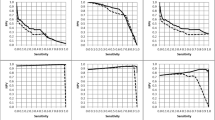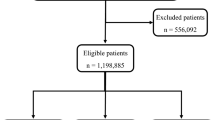Abstract
Purpose
The AIS scale is a measurement tool for single injuries. The ISS is considered the gold standard for determining the severity of injured patients, and the NISS was developed to improve the ISS with respect to loss of information, as well as to facilitate its calculation. The aim of this study was to analyse what injury severity measure, calculated according to the Abbreviated Injury Scale (AIS), 1998 and 2005 (update 2008) versions, performs better with mortality, cost and hospital length of stay healthcare indicators.
Methods
This cross-sectional observational study was carried out between February 1st 2012 and February 1st 2013. Inclusion criteria were injured patients due to external causes admitted to trauma service through the emergency department. Manual coding of all injuries was performed and ISS and NISS scores were calculated for both versions of the AIS scale. Severity was then compared to mortality (in-hospital and at 30 days), healthcare cost, and length of hospital stay.
Results
The index with the best predictive capability for in-hospital mortality was NISS 05 (AUC = 0.811). There was a significant increase in hospital stay and healthcare cost in the most severe patients in all indexes, except for ISS 05.
Conclusions
NISS is found to be an index with higher predictive capability for in-hospital mortality and correlates better to length of hospital stay and healthcare cost.


Similar content being viewed by others
References
Association for the Advancement for Automotive Medicine. Escala de Lesiones Abreviada 2005. Actualización 2008. Ed. Des Plaines: AAAM; 2008.
Salottolo K, Settell A, Uribe P, Akin S, Slone DS, O’Neal E, et al. The impact of the AIS 2005 revision on injury severity scores and clinical outcome measures. Injury. 2009;40(9):99–1003.
Leth PM, Ibsen M. Abbreviated injury scale scoring in traffic fatalities: comparison of computerized tomography and autopsy. J Trauma. 2010 Jun;68(6):1413–6.
Baker SP, O’neill B, Haddon W, Long WB. The injury severity score: development and potential usefulness. Proc Am Assoc Automot Med Annu Conf. 1974;18:58–74.
Osler T, Baker SP, Long W. A modification of the injury severity score that both improves accuracy and simplifies scoring. J Trauma Acute Care Surg. 1997;43(6):922–6.
Association for the Advancement for Automotive Medicine. The abbreviated injury scale. Revision 1990. Ed. Des Plaines: AAAM; 1990.
Association for the Advancement for Automotive Medicine. The abbreviated injury scale. Revision 1990. Update 1998. Ed. Des Plaines: AAAM; 1998.
Lavoie A, Moore L, LeSage N, Liberman M, Sampalis JS. The new Injury Severity Score: a more accurate predictor of in-hospital mortality than the Injury Severity Score. J Trauma Acute Care Surg. 2004;56(6):1312–20.
Haider AH, Villegas CV, Saleem T, Efron DT, Stevens KA, Oyetunji TA, et al. Should the IDC-9 trauma mortality prediction model become the new paradigm for benchmarking trauma outcomes? J Trauma Acute Care Surg. 2012 72(6):1695–701.
Nogueira L, Domingues C, Campos M, Sousa R. Ten years of new injury severity score (NISS): is it a possible change? Rev Lat Am. 2008;16(2):314–9.
Van Belleghem G, Devos S, De Wit L, Hubloue I, Lauwaert D, Pien K, et al. Predicting in-hospital mortality of traffic victims: a comparison between AIS-and ICD-9-CM-related injury severity scales when only ICD-9-CM is reported. Injury. 2016;47(1):141–6.
OMS. Informe sobre la situación mundial de la seguridad vial: es hora de pasar a la acción. Ginebra; 2009. Available at: http://www.who.int/violence_injury_prevention/road_safety_status/report/web_version_es.pdf.
European Commission, Directorate-General for Internal Market, Industry, Entrepreneurship and SMEs. Report from the Commission to the European Parliament and The Council Saving Lives. Boosting Car Safety in the EU Reporting on the monitoring and assessment of advanced vehicle safety features, their cost effectiveness and feasibility for the review of the regulations on general vehicle safety and on the protection of pedestrians and other vulnerable road users. 2016; COM/2016/0787 final.
Abajas R, Leal C, Ortego MC, Zonfrillo M, Seguí M, Durá M. Grado de correlación entre las versiones 98 y 2005 (actualización 2008) de la Abbreviated Injury Scale (AIS) en la categorización del paciente traumatológico grave. Emergencias. 2018;30:41–4.
Copes W, Champion H, Sacco W, Lawnick M, Keast S, Bain L. The injury severity score revisited. J Trauma Acute Care Surg. 1988;28(1):69–77.
Stewart KE, Cowan LD, Thompson DM. Changing to AIS 2005 and agreement of injury severity scores in a trauma registry with scores based on manual chart review. Injury. 2011;42(9):934–9.
Lemeshow S, Hosmer Jr DW. A review of goodness of fit statistics for use in the development of logistic regression models. Am J Epidemiol. 1982;115(1):92–106.
Gorra AS, Clark DE, Mullins RJ. Using hospital outcomes to predict 30-day mortality among injured patients insured by Medicare. Arch Surg. 2011;146(2):195–200.
Mullins RJ, Mann NC, Hedges JR, Worrall W, Helfand M, Zechnich AD, et al. Adequacy of hospital discharge status as a measure of outcome among injured patients. JAMA. 1998;279(21):1727–31.
Clark DE, DeLorenzo MA, Lucas F, Wennberg DE. Epidemiology and short-term outcomes of injured medicare patients. J Am Geriatr Soc. 2004;52(12):2023–30.
Pérez K, Cirera E, Plaséncia A. Estudio de la Mortalidad a 30 días por Accidentes de Tráfico (EMAT-30). Ministerio de Sanidad y Consumo ed.: Ministerio de Sanidad y Consumo; 2004.
Tohira H, Jacobs I, Mountain D, Gibson N, Yeo A. Systematic review of predictive performance of injury severity scoring tools. Scand J Trauma Resusc Emerg Med. 2012;20(1):63.
Ringdal KG, Coats TJ, Lefering R, Di Bartolomeo S, Steen PA, Røise O, et al. The Utstein template for uniform reporting of data following major trauma: a joint revision by SCANTEM, TARN, DGU-TR and RITG. Scand J Trauma Resusc Emerg Med. 2008;16(1):7.
Balogh ZJ, Varga E, Tomka J, Süveges G, Tóth L, Simonka JA. The new injury severity score is a better predictor of extended hospitalization and intensive care unit admission than the injury severity score in patients with multiple orthopaedic injuries. J Orthop Trauma. 2003;17(7):508–12.
Tohira H, Jacobs I, Matsuoka T, Ishikawa K. Impact of the version of the abbreviated injury scale on injury severity characterization and quality assessment of trauma care. J Trauma. 2011;71(1):56–62.
Zhao X, Zhang M, Gan J, Xu S, Jiang G. Comparison of the new injury severity score and the injury severity score in multiple trauma patients. Chin J Traumatol (English Edition). 2008;11(6):368–71.
Aharonson-Daniel L, Giveon A, Stein M, Israel Trauma Group (ITG), Peleg K. Different AIS triplets: different mortality predictions in identical ISS and NISS. J Trauma. 2006;61(3):711–7.
Rutledge R. The injury severity score is unable to differentiate between poor care and severe injury. J Trauma Acute Care Surg. 1996;40(6):944–50.
Acknowledgements
The authors are grateful to doctors Fernando Rojo and Tomás Belzunegui for providing access to data, to the members of the Nursing School of the University of Cantabria for their support and to Montse Ruiz for the translation of the manuscript.
Author information
Authors and Affiliations
Corresponding author
Ethics declarations
Conflict of interest
The authors declare that we have no conflict of interest.
Rights and permissions
About this article
Cite this article
Abajas Bustillo, R., Amo Setién, F.J., Ortego Mate, M.d.C. et al. Predictive capability of the injury severity score versus the new injury severity score in the categorization of the severity of trauma patients: a cross-sectional observational study. Eur J Trauma Emerg Surg 46, 903–911 (2020). https://doi.org/10.1007/s00068-018-1057-x
Received:
Accepted:
Published:
Issue Date:
DOI: https://doi.org/10.1007/s00068-018-1057-x




